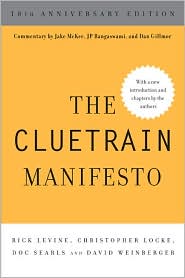June 11, 2009
[newmedia] Measuring social media’s effects
|
NOTE: Live-blogging. Getting things wrong. Missing points. Omitting key information. Introducing artificial choppiness. Over-emphasizing small matters. Paraphrasing badly. Not running a spellpchecker. Mangling other people’s ideas and words. You are warned, people. |
Q: How do you define social media at Whirlpool?
Brian Synder: It has to be defined separately for each area, and we tie it back to business objectives. We track share of voice and favorability. On customer service, we do interesting text mining.
Lee Aase (Mayo Clinic): We use the free tools that are available. “The need for measurement varies inversely with the amount of money you spend on it.” We use the measurement tools to prove the value of what we’re doing.
Q: Your biggest challenge?
Marcel Lebrun (Radian6): We only measure if there’s a practical purpose. Social media are now multi-purpose. We use social media for every possible purpose. So, it’s disrupting everything in the enterprise that has to do with reaching out to customers. But those different practices have different business goals and thus different needs for measurement.
Q: Where it’s going?
Marcel: In the past six months, we’ve gone from explaining what social media is, to businesses understanding that their brand is the sum of all the conversations about it.
[Missed some. Sorry]
Q: How do you measure influencers for a brand?
Marcel: We integrate a bunch of digital breadcrumbs and social metrics. We measure things like how often a person talks about a subject, how much comments, how many unique comments, inbound links, which ones of those are also talking about that topic. Influence is very topic-centric. You sometimes want to see total reach, and sometimes you just want to find the topic geeks.
Q: How do you determine sentiment?
Brian: Synergy1 has humans reading the posts. The Tensity program automates this.
Lee: We eyeball it. And we’re looking for the really positive ones so we can spread the word and engage.
Brian: We look to engage by actually talking about product issues. E.g., an unhappy customer was tweeting about a product arriving damaged three times. We talked with him and redesigned the packaging based on his suggestions. We’ve taught some of our customer care phone folks how to engage via social media.
Marcel: The bulk of brands are at the listen stage. But Dell has a full blogger outreach team, focused on different kinds of users. The measure quantitatively and qualitatively (e.g., stories).
Marcel: The fastest way to get a new feature into a product is to tweet it. The developers get excited. They like being in touch.








